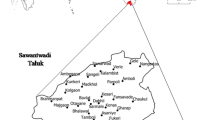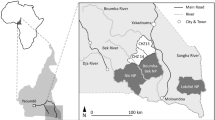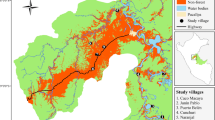Abstract
In a number of places, sacred forest sites play an important role in conservation and local livelihoods. Here we examine how Iban hunters and animals alike use sacred forest in West Kalimantan, Indonesia. To determine the relative importance of different sites in hunting, we compare hunting effort, animal species and their numbers encountered by hunters, and encounters and captures in a variety of forest sites including sacred groves. We relate the results to the role of such sites in the overall Iban agroforestry system and in the conservation of forest habitat that professional conservationists deem precious. Such land use practices, while having social and religious origins, may be important for local economic purposes, but they may also be valuable in promoting and enhancing the more global goals of biodiversity conservation.
Similar content being viewed by others
REFERENCES
Aglionby, J., and Whiteman, A. (1996). The Utilisation of Economic Data for Conservation Man-agement Planning: A Case Study From Danau Sentarum Wildlife Reserve, Conservation Project, Indonesia–UK Tropical Forest Management Programme, Pontianak.
Alvard, M. S. (1998). Evolutionary ecology and resource conservation. Evolutionary Anthro-pology 7: 62–74.
Appell, G. N. (in press). The ecological and social consequences of conversion to Christianity among the Rungus Dusun of Sabah, Malaysia. In Tan, C. (ed.), Development and Indige-nous Minorities in Southeast Asia, Contributions to Southeast Asian Ethnography, No. 11.
Appell, G. N., Sather, C., and Wadley, R. L. (2001). Sacred places, sacred sites, and memorial groves. In Sutlive, V. H., and Sutlive, J. (eds.), The Encyclopedia of Iban Studies, Vol. 3, The Tun Jugah Foundation, Kuching, Malaysia, pp. 1629–1634.
Balée, W. (1994). Footprints in the Forest: Ka'apor Ethnobotany—The Historical Ecology of Plant Utilization by an Amazonian People, Columbia University Press, New York.
Barrett, R. J., and Lucas, R. H. (1993). The skulls are cold, the house is hot: Interpreting depths of meaning in Iban therapy. Man 28: 573–596.
Basu, R. (2000). Studies on sacred groves and taboos in Purulia District of West Bengal. Indian Forester 126: 1309–1318.
Beckerman, S., and Valentine, P. (1996). On native American conservation and the tragedy of the commons. Current Anthropology 37: 659–661.
Berkes, F. (1999). Sacred Ecology: Traditional Ecological Knowledge and Resource Manage-ment, Taylor and Francis, Philadelphia.
Bernstein, J. H., Ellen, R., and Antaran, B. (1997). The use of plot surveys for the study of ethnobotanical knowledge: A Brunei Dusun example. Journal of Ethnobiology 17: 69–96.
Burman, Y. J. R. (2003). Sacred Groves Among Communities: The Mahadeo Kolis and the Kunbis of the Western Ghats, Mittal, New Delhi.
Byers, B. A., Cunliffe, R. N., and Hudak, A. T. (2001). Linking the conservation of culture and nature: A case study of sacred forests in Zimbabwe. Human Ecology 29: 187–218.
Caldecott, J. (1988). Hunting and Wildlife Management in Sarawak, IUCN, Gland.
Chandran, M. D. S., and Hughes, J. D. (2000). Sacred groves and conservation: The comparative history of traditional reserves in the Mediterranean and in South India. Environment and History 6: 169–186.
Chandrashekara, U. M., and Sankar, S. (1998). Ecology and management of sacred groves in Kerala, India. Forest Ecology and Management 112: 165–177.
Christensen, H. (2001). Plant names and plant classification in an Iban community in Sarawak, Malaysia. In Sutlive, V. H., and Sutlive, J. (eds.), The Encyclopedia of Iban Studies. Vol. 1, The Tun Jugah Foundation, Kuching, Malaysia, pp. 239–262.
Colding, J., and Folke, C. (2001). Social taboos: "Invisible" systems of local resource manage-ment and biological conservation. Ecological Applications 11: 584–600.
Colfer, C. J. P., and Dudley, R. G. (1993). Shifting Cultivators of Indonesia: Marauders or Man-agers of the Forest? Rice Production and Forest Use Among the Uma' Jalan of East Kali-mantan, Community Forestry Case Study Series, No. 6, FAO, Rome.
Colfer, C. J. P., Peluso, N., and Chin S. C. (1997). Beyond Slash and Burn: Lessons From the Kenyah on Management of Borneo's Rain Forests, New York Botanical Gardens, New York.
Colfer, C. J. P., and Wadley, R. L. (2001). From "participation" to "rights and responsibilities" in forest management: Workable methods and unworkable assumptions in West Kali-mantan, Indonesia. In Colfer, C. J. P., and Byron, Y. (eds.), People Managing Forests: The Links Between HumanWell-Being and Sustainability, RFFPress, Washington, DC, pp. 278–299.
Colfer, C. J. P., Wadley, R. L., Suriansyah, B., and Widjanarti, E. (1993). Use of forest products in three communities: A preliminary view. In Conservation Sub-Project Quarterly Report (June), Indonesia Tropical Forestry Management Project, Asian Wetlands Bureau, Bogor, Indonesia.
Colfer, C. J. P., Wadley, R. L., Salim, A., and Dudley, R. G. (2000). Understanding patterns of resource use and consumption: A prelude to co-management. Borneo Research Bulletin 31: 29–88.
Colfer, C. J. P., Wadley, R. L., Harwell, E., and Prabhu, R. (2001). Assessing intergenerational access to resources: Using criteria and indicators in West Kalimantan, Indonesia. In Colfer, C. J. P., and Byron, Y. (eds.), People Managing Forests: The Links Between Human Well-Being and Sustainability, RFF Press, Washington, DC, pp. 190–213.
Cramb, R. A. (1989). Explaining variations in Bornean land tenure: The Iban case. Ethnology 28: 277–300.
Cramb, R. A. (1993). Shifting cultivation and sustainable agriculture in East Malaysia: A lon-gitudinal study. Agricultural Systems 42: 209–226.
Decher, J. (1997). Conservation, small mammals, and the future of sacred groves in West Africa. Biodiversity and Conservation 6: 1007–1026.
Dorm-Adzobu, C., and Ampadu-Agyei, O. (1995). The Malshegu sacred grove, Ghana. In Sigot, A., Thrupp, L. A., and Green, J. (eds.), Towards Common Ground: Gender and Natural Resource Management in Africa, ACTS Press, Nairobi, pp. 49–64.
Dove, M. R. (1981). Subsistence Strategies in Rain Forest Swidden Agriculture, PhD Thesis, Stanford University, Stanford, CA.
Dove, M. R., and Kammen, D. M. (1997). The epistemology of sustainable resource use: Man-aging forest products, swiddens, and high-yielding variety crops. Human Organization 56: 91–101.
Eilenberg, M. (2003). Modige Drenge og Dydige Piger: Et Antropologisk Studie af Børn, med Fokus p° a Social Forandring blandt Ibanerne i Vest Kalimantan, Indonesien. Feltrapport, Afdelingen for Etnografi og Socialantropologi, ° Arhus Universiteit, Moesg° ard, Denmark.
Emmons, L. H. (1992). The roles of small mammals in tropical rainforest. In Ismail, G., Mohamed, M., and Omar, S. (eds.), Proceedings of the International Conference on For-est Biology and Conservation in Borneo, July 30–August 3, 1990, Kota Kinabalu, Sabah, Malaysia, Yayasan Sabah, Kota Kinabalu, pp. 512–513.
Francis, C. M. (1984). Pocket Guide to the Birds of Borneo, The Sabah Society and World Wildlife Fund Malaysia, Kota Kinabalu and Kuala Lumpur.
Francis, C. M. (1990). Trophic structure of bat communities in the understorey of lowland dipterocarp rain forest in Malaysia. Journal of Tropical Ecology 6: 421–431.
Freeman, D. (1970). Report on the Iban, Athlone Press, London.
Giesen, W. (1987). Danau Sentarum Wildlife Reserve: Inventory, Ecology and Management Guidelines, WWF and PHPA, Bogor.
Giesen, W., and Aglionby, J. (2000). Introduction to Danau Sentarum National Park, West Kalimantan, Indonesia. Borneo Research Bulletin 31: 5–28.
Hollander, M., and Wolfe, D. A. (1973). Nonparametric Statistical Methods, Wiley, New York.
Hunn, E. S., Johnson, D. R., Russell, P. N., and Thornton, T. F. (2003). Huna Tlingit traditional environmental knowledge, conservation, and the management of a "wilderness" park. Current Anthropology 44(Suppl): S79–S103.
Jepson, P., and Canney, S. (2003). Values-led conservation. Global Ecology and Biogeography 12: 271–274.
Jordan, C. F. (1986). Local effects of tropical deforestation. In Soulé, M. E. (ed.), Conserva-tion Biology: The Science of Scarcity and Diversity. Sinauer Associates, Sunderland, MA, pp. 410–426.
Kecamatan Batang Lupar (1995). Data penduduk wilayah Kecamatan Batang Lupar, Oktober 1995, Kantor Camat, Kecamatan Batang Lupar, Lanjak.
King, V. T. (1996). Environmental change in Malaysian Borneo. In Parnwell, M. J. G., and Bryant, R. L. (eds.), Environmental change in South-East Asia: People, Politics and Sus-tainable Development, Routledge, London, pp. 165–189. Lahm, S. A. (1993). Ecology and Economics of Human/Wildlife Interaction in Northeastern Gabon, PhD Thesis, New York University. Lawrence, D. C., Leighton, M., and Pearce, D. R. (1995). Availability and extraction of forest products in managed and primary forest around a Dayak village in West Kalimantan, Indonesia. Conservation Biology 9: 76–88. Lebbie, A. R., and Guries, R. P. (1995). Ethnobotanical value and conservation of sacred groves of the Kpaa Mende in Sierra Leone. Economic Botany 49: 297–308. Leighton, M., and Leighton, D. R. (1983). Vertebrate responses to fruiting seasonality within a Borneo rain forest. In Sutton, S. L., Whitmore, T. C., and Chadwick, A. C. (eds.), Tropical Rain Forest: Ecology and Management, Blackwell, Oxford, pp. 181–196. Lyman, R. L. (2003). Pinniped behavior, foraging theory, and the depression of metapopula-tions and nondepression of a local population on the southern Northwest Coast of North America. Journal of Anthropological Archaeology 22: 376–388. McWilliam, A. (2001). Prospects for the sacred grove: Valuing lulic forests on Timor. The Asia Pacific Journal of Anthropology 2: 89–113. Padoch, C. (1982). Migration and Its Alternatives Among the Iban of Sarawak, Martinus Nijhoff, The Hague. Padoch, C., and Peters, C. (1993). Managed forest gardens in West Kalimantan, Indonesia. In Potter, C. S., Cohen, J. I., and Janczewski, D. (eds.), Perspectives on Biodiversity: Case Studies of Genetic Resource Conservation and Development, AAAS Press, Washington, DC, pp. 167–176. Payne, J., Francis, C. M., and Phillipps, K. (1985). A Field Guide to the Mammals of Borneo, The Sabah Society and World Wildlife Fund Malaysia, Kota Kinabalu and Kuala Lumpur. Pearce, K., Amen, V. L., and Jok, S. (1987). An ethnobotanical study of an Iban community of the Pantu Sub-District, Sri Aman, Division 2, Sarawak. Sarawak Museum Journal 37: 193–270. Peterson, J. T. (1981). Game, farming, and interethnic relations in northeastern Luzon, Philippines. Human Ecology 9: 1–22. Posey, D. (1985). Indigenous management of tropical forest ecosystems: The case of the Kayap´ o Indians of the Brazilian Amazon. Agroforestry Systems 3: 139–158. Ramakrishnan, P. S., Saxena, K. G., and Chandrashekara, U. M. (eds.) (1998). Conserving the Sacred: For Biodiversity Management. Science Publishers, Enfield, NH. Rigg, J. (1993). Forest and farmers, land and livelihoods: Changing resource realities in Thailand. Global Ecology and Biogeography Letters 3: 270–289. Salafsky, N. (1994). Forest gardens in the Gunung Palung region of West Kalimantan, Indonesia: Defining a locally-developed, market-oriented agroforestry system. Agroforestry Systems 28: 237–268. Sather, C. (1990). Trees and tree tenure in Paku Iban society: The management of secondary forest resources in a long-established Iban community. Borneo Review 1: 16–40. Sinha, R. K. (1995). Biodiversity conservation through faith and tradition in India: Some case studies. International Journal of Sustainable Development and World Ecology 2: 278–284. Smith, E. A., and Wishnie, M. (2000). Conservation and subsistence in small-scale societies. Annual Review of Anthropology 29: 493–524. Smythies, B. E. (1981). The Birds of Borneo, 3rd edn. The Sabah Society and the Malayan Nature Society, Kota Kinabalu and Kuala Lumpur. Snow, D. W. (1981). Tropical frugivorous birds and their food plants: Aworld survey. Biotropica 13: 1–14. Sponsel, L. E., Natadecha-Sponsel, P., Ruttanadakul, N., and Juntadach, S. (1998). Sacred and/or secular approaches to biodiversity conservation in Thailand. Worldviews: Environment, Culture, Religion 2: 155–167. Susilo, A. (1992). Seed dispersal agents at Mentoko burned-over forest, Kutai National Park, East Kalimantan, Indonesia. In Ismail, G., Mohamed, M., and Omar, S. (eds.), Proceedings of the International Conference on Forest Biology and Conservation in Borneo, July 30– August 3, 1990, Kota Kinabalu, Sabah, Malaysia, Yayasan Sabah, Kota Kinabalu, pp. 516– 517. Swamy, P. S., Kumar, M., and Sundarapandian, S. M. (2003). Spirituality and ecology of sacred groves in Tamil Nadu, India. Unasylva 54: 53–58. Terborgh, J. (1995). Wildlife in managed tropical forests: A neotropical perspective. In Lugo, A. E., and Lowe, C. (eds.), Tropical Forests: Management and Ecology, Springer-Verlag, New York, pp. 331–342. Wadley, R. L. (1997). Variation and changing tradition in Iban land tenure. Borneo Research Bulletin 28: 98–108. Wadley, R. L. (2002). Iban forest management and wildlife conservation along the Danau Sentarum periphery, West Kalimantan, Indonesia. Malayan Nature Journal 56: 83–101. Wadley, R. L. (in press). Complex agroforests and their possible role in fallow management and forest regeneration: Speculations on the Iban of West Kalimantan, Indonesia. In Cairns, M. (ed.), Indigenous Strategies for Intensification of Shifting Cultivation in Asia-Pacific, RFF Press, Washington, DC. Wadley, R. L., Colfer, C. J. P., and Hood, I. G. (1997). Hunting primates and managing forests: The case of Iban forest farmers in West Kalimantan, Indonesia. Human Ecology 25: 243– 271. Wadley, R. L., Dennis, R. A., Meijaard, E., Erman, A., Valentinus, H., and Giesen, W. (2000). Af-ter the conservation project: Danau Sentarum National Park and its vicinity—Conditions and prospects. Borneo Research Bulletin 31: 385–401. Warner, K. (1991). Shifting Cultivators: Local Technical Knowledge and Natural Resource Man-agement in the Humid Tropics, FAO Community Forestry, Rome. Western, D., and Wright, R. M. (eds.) (1994). Natural Connections: Perspectives in Community-Based Conservation, Island Press, Washington, DC. Whitmore, T. C. (1986). Tropical Rain Forests of the Far East, ELBS edn., Oxford University Press, Oxford.
Author information
Authors and Affiliations
Rights and permissions
About this article
Cite this article
Wadley, R.L., Colfer, C.J.P. Sacred Forest, Hunting, and Conservation in West Kalimantan, Indonesia. Human Ecology 32, 313–338 (2004). https://doi.org/10.1023/B:HUEC.0000028084.30742.d0
Issue Date:
DOI: https://doi.org/10.1023/B:HUEC.0000028084.30742.d0




